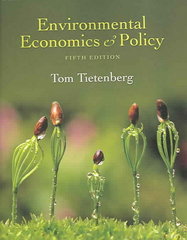Question
Test 2 ECN 441 - Spring 2021 Arizona State University 24 hrs, 100 pts in total Exercise 1 - 20 pts Answer the following questions
Test 2
ECN 441 - Spring 2021 Arizona State University
24 hrs, 100 pts in total
Exercise 1 - 20 pts
Answer the following questions in 5 lines tops.
- How was the convexity of preferences assumption important for making the argument that competitive equilibria are efficient? Does this mean convexity is necessary for the FWT to hold? Explain. (10 pts)
- Is convexity of the production set a necessary assumption for the SWT to hold? Explain. (10 pts)
Exercise 2 - 20 pts
Agent A is endowed with a car that he values at $200, and with $1,000 in cash. Agent B has no car, values A's car at $350, and is endowed with $1,000 in cash. Let's formally describe the utility functions for this problem. Agent i has utility over car and money equal to:
ui = Xi + mi
where mi denotes the amount of money consumed by agent i. XA equals zero if agent A does not consume the car, and 200 if he does. XB equals zero if agent B does not consume the car, and 350 if he does.
1. What are the competitive equilibrium prices? (10 pts)
2. At any competitive equilibrium allocation, who gets the car? (10 pts)
Exercise 3 - 30 pts
Consider the following economy with production. There is a firm which can turn one unit of oranges into two apples, or two units of oranges into three apples. There is a consumer who is endowed with two oranges. The consumer sees apples and oranges as perfect complements, i.e. her utility function for consuming apples a and oranges o is,
u = min(o, a)
Restrict your attention to allocations that have only integer values - i.e. it is not possible
to demand or supply fractional units of either good.
- What is the set of Pareto Optimal allocations? (10 pts)
- Consider the price system where po/pa = 2. What are the firm's profit-maximizing production plans? What are the firm's profits? (10 pts)
- Is po/pa = 2 an equilibrium price ratio? Explain. (10 pts)
Exercise 4 - 30 pts
Consider the following economy with production. There is a worker endowed with 1 unit of time, which can be allocated either to leisure or labor. There is a firm with a technology that turns a worker's labor (the complement of his leisure) into bread. That technology satisfies:
b(l) = l1/2
where l [0,1] denotes the worker's labor and b(l) is the amount of bread produced as a function of labor input. The worker's utility function from labor supplied and bread consumed is:
u(l,b)=ln(b)l, 0<<2
- What is the set of Pareto optimal allocations in this economy? (15 pts)
- Provide prices and an allocation that, together, constitute a competitive equilibrium in this economy. (15 pts)
2
Step by Step Solution
There are 3 Steps involved in it
Step: 1

Get Instant Access to Expert-Tailored Solutions
See step-by-step solutions with expert insights and AI powered tools for academic success
Step: 2

Step: 3

Ace Your Homework with AI
Get the answers you need in no time with our AI-driven, step-by-step assistance
Get Started


